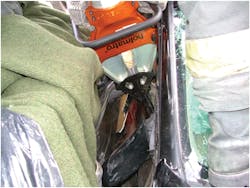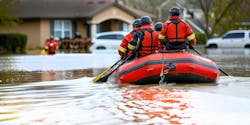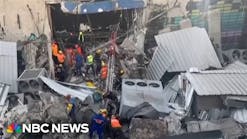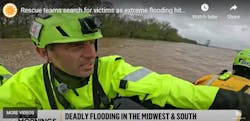Many of the nation’s fire departments and rescue squads provide technical rescue services to their respective communities. One arena that is very common to many organizations is motor vehicle extrication. While newspapers and other media are constantly showing pictures of disentanglement actions, many do not realize the preparation and logistical work that goes into a successful extrication operation. We will look at some of these characteristics, discuss some of the more common extrication maneuvers, and then showcase some of the more ornate maneuvers for those times when we need to operate during extraordinary circumstances.
When we think extrication, we are really talking about disentanglement, the actual removal of the vehicle from around the victim (see Photo 1). Removal, or extrication of the victim, comes after the disentanglement work on the vehicle. That will vary greatly, depending on the severity of the impact, and the composition of both materials that have been involved in the accident.
So, what should the local service provider be bringing to the scene? First and foremost, trained, skilled personnel are the number one asset on any rescue scene, and extrication is not any different. Training will not only be focused on disentanglement skills; we will need people to perform stabilization, provide medical treatment to the victims, and control the threat of fires on these scenes. Additionally, depending on the vehicles involved, a response from the local Haz/Mat team may be in order. These skills will not become second nature without many hours of hands-on work with the tools and equipment associated with these techniques (see Photo 2). The extrication scene is a dynamic event; it is always changing, and has the potential to go bad quickly (see Photo 3). Therefore, I would be remiss not to emphasize the use of full personal protective equipment (PPE), including secondary eye protection above helmet shields, Body Substance Isolation (BSI) equipment, turnout gear, and crash gear for firefighters and EMTs, etc…. Any lack or disregard of the use of these basic protective ensemble components can lead to serious injury, and there is no permissible excuse for it.
Your department is dispatched to a reported vehicle accident with entrapments. This is the time to start your size-up, not at the accident scene. A lot of information can be gathered by the dispatch assignment. For example, the type of road (residential street, highway) can provide clues on the speed of impact you can expect. The location of the area may provide information about what hazards may be involved, such as type of vehicle, industrial equipment (forklifts and construction vehicles have accidents, too) and access to the scene issues (see Photo 4). One major point that should be considered in the size up is the “Golden Hour,” which is the time related to the onset of impact until the patient is receiving definitive, medical care at an approved medical facility. The problem with this is that the Golden Hour clock had started running before the responders had been dispatched; one can only estimate the amount of time elapsed, based on time of alarm, reflex time to respond, and traffic problems impeding access to the scene. Since this is difficult to ascertain with any degree of certainty, it is wise to focus the on-scene efforts towards the “Platinum Ten,” which is the optimum time frame when the responders arrive until the patient is disentangled and extricated from the vehicle. Keeping the total extrication time to less than ten minutes will help to keep operations closer to within the Golden Hour.
Read the Wreckage
Upon arrival, initial responders should be sent towards the wreckage and perform an Inner Circle Survey of the incident. This is a total 360-degree walk around the incident, looking towards the wreckage, to help obtain some vital information about the incident. Take note of issues like the number of victims, doors locked or jammed, vehicles still running, leaking fluids or fuels, involved utilities (electric/gas), and potential victim access. Be sure to take the time to “Read the Wreckage” for impact-related injuries. Reading the wreckage takes into consideration the kinetic energy (the force of energy in motion) that led to the potential traumatic injuries caused as energy is transferred through the vehicle (see Photo 5). The sudden stop from the accident will transform this energy into damage to the vehicles. Those forces are also transmitted through the occupants as well, and can be compounded by vehicles that are moving in opposite directions (head-on impact). Consider the magnitude of the impact at the scene: first, the vehicle collides with an object, and then the victim collides with the vehicle. Finally, the victim’s internal organs collide with one another. The final collision is the one that can do the most damage to the victim. Identifying these impact signatures will help identify potential mechanisms of injury that crews can expect to encounter in victims on-scene.
For example, frontal collisions result in more fatalities than any other point of impact. During frontal collisions, both vehicles are moving at approximately the same speed, meaning that they possess similar kinetic energy. At the moment they undergo a collision, their energy is added together. So, if both vehicles were traveling at 35 miles per hour, their force of impact would be similar to hitting a stationary object at 70 miles per hour. Rear-end collisions can contribute to injury and stresses to the neck, back, and spine. Side-impact collisions can result in serious head and neck injuries, considering these are small spaces with thin crumple zones, and limited protection, at best. Rollovers result in many ejection fatalities, with unrestrained victims being thrown through openings from broken glass.
Construction Types
Additionally, identifying the type of vehicle involved in the extrication will help identify types of methods that will be used during operations, based on strong points of the vehicles for stabilization and disentanglement. Vehicles will range in size, horsepower rating, amenities, safety features, and construction techniques. Three of these construction types include Full Frame, Unibody, and Space Frame vehicles.
Full Frame vehicles incorporate frame rails that run from the front of the vehicle, underneath the passenger compartment, to the rear of the vehicle. These rails provide mounting support for passenger compartments, powertrains, and other vehicular components.
Unibody vehicles have short frame rails that terminate underneath the vehicle, at the front of the passenger compartment or firewall area. This type of construction utilizes the passenger compartment for integrity and stability.
Space Frame utilizes a steel cage-like structure that carries the vehicle’s loads and stresses, and holds the vehicle together.
These types of construction will be found in all types of vehicles, ranging from subcompacts, compacts, full size, sport-utility vehicles, limousines, pick-up trucks, and minivans. The best way to tell on-scene is to look underneath the vehicle to check for frame rails, and to see where they terminate. If there are no full-length frame rails, then expect Unibody or Space Frame construction.
New car technology has made some significant strides in the last decade, but some have led to problematic issues on the rescue scene:
- Reinforced wheel and engine deflection systems allow the wheels and engine components to deflect under the vehicle and away from the passengers.
- Crumple zones in engine compartments have been designed to absorb more energy.
- Impact bars constructed of boron or micro-alloy steel can add to problems when crews are trying to remove or open the door of a vehicle.
- Air bags and seat belt pre-tensioners can now be found almost anywhere inside the vehicle (see Photos 6 and 7). These mechanisms have been the cause of many rescuer injuries.
- New technology of glass is designed to keep the unrestrained passenger inside the vehicle during impact; it can also make gaining access for rescuers much more difficult.
- Batteries are now located anywhere throughout the vehicle, creating an energizing issue for much of the wreckage.
- Front and rear bumpers can become “loaded” after impact, resulting in the bumper assembly becoming a projectile during the extrication.
- Various fuel types, including hybrid-powered vehicles, can add high voltage and explosive concerns to the operation.
The key to success with these advancements is to identify them early on in the operation, so adequate safety precautions can be taken. There are many case histories of rescuers being hurt and severely injured due to some of these “safety” devices.
While the Inner Circle Survey is being done, another team of rescuers shall be performing an Outer Circle Survey as well. An Outer Circle Survey is a complete walk around the entire accident scene, facing outward (away from the incident). These rescuers are looking for additional issues related to the incident, such as damaged buildings that need structural support, ejected victims away from the incident, victims struck away from the incident, walking wounded victims, vehicles involved in the accident that came to rest away from the incident, and utility damage away from the incident. These situations may not be identified by the arriving crews, due to tunnel vision and focusing on the obvious victims; do not fall victim to this trap, be sure to do thorough surveys when arriving on the accident scene.
Stabilization
Now that we have identified some of the important points of the response and the on-scene size-up, it is imperative to stabilize the vehicle. Stabilization is the application of equipment and techniques designed to stop the vehicle from moving in any direction. We accomplish this by focusing our stabilization concerns in three different categories.
Horizontal Stabilization involves stopping vehicular movement from front to back, which can employ chocking tires, deflating tires, putting the vehicle in park, and setting the parking brake.
Vertical Stabilization stops vehicular movement up and down, by use of step chocks, box cribbing, and rescue struts.
Box Cribbing is the stabilization process of choice by many rescue teams. This technique uses wood or plastic crib materials (usually dimensional timber, 4" x 4" or 6" x 6") and stacked in a perpendicular fashion to support the weight of the vehicles (see Photo 8).
Plastic composite cribbing material strength is determined by the manufacturer, while the rule of thumb for wood cribbing is 500 pounds per square inch of surface contact area. For example, if a rescue crew uses 4" x 4" cribbing, stacked two per tier, we can determine the strength of the crib by measuring the surface contact area. 4" x 4" timber is actually 3.5" x 3.5", which when multiplied, equals 12.25". There are four points of contact in a two-tier box crib, which when multiplied by the surface area equals 49" (12.25 x 4 = 49"). Multiply the total surface area by 500; the strength of this specific box crib equals 24,500 pounds of strength, per box crib. If the crew deploys four points of stabilization using box cribbing, then the weight that can be supported can be significant.
Along with cribbing materials, there are many manufacturers of vehicle stabilization kits that can be utilized for stabilization of vehicles. These kits include rescue struts with a complement of various bases and adaptors to adapt to the condition of the wreckage. These kits serve as great tools of choice for vehicles that wind up on their sides and on their roofs. When choosing which kit to employ in your response area, it is important to research the many different options that are offered in some of these kits, and then decide which one works best for your department.
Interior Stabilization is the last category of stabilization. This includes putting the vehicle in park, shutting off the ignition, removing the key from the vehicle, rolling down all of the windows, opening the truck and the hood when applicable, moving power seats back slowly if capable, lifting tilt-wheel settings, and moving electric pedals out of the way for the operation. This will require a rescuer to get into the vehicle and make patient contact; therefore, be sure to provide both horizontal and vertical stabilization prior to sending a rescuer into the vehicle for any reason.
Conclusion
As you can see, there are a lot of steps and considerations that must be taken into account before the rescuer can begin to displace any metal from the vehicle. It is vital that crews act quickly and efficiently to perform these initial activities so that the actual disentanglement and extrication can take place within the “Platinum Ten” time frame. Next month, we will look at gaining access into the vehicle, purchase points, and some basic component displacement techniques.
Until next time, stay focused and stay safe.
MICHAEL P. DALEY is a lieutenant and training officer with the Monroe Township, NJ, Fire District No. 3, and is an instructor with the Middlesex County Fire Academy, where he is responsible for rescue training curriculum development. Mike has an extensive background in fire service operations and holds degrees in business management and public safety administration. Mike serves as a rescue officer with the New Jersey Urban Search and Rescue Task Force 1 and is a managing member for Fire Service Performance Concepts, a consultant group that provides assistance and support to fire departments with their training programs and course development. Mike has been guest on several Firehouse.com podcasts including: Successful Rescue Operations in Today's Fire Service, Preparing for Tomorrow's RIT Deployment Today and Basement Fire Tactics Roundtable podcasts. View all of Michael's articles and podcasts here. You can reach Michael by e-mail at: [email protected].






